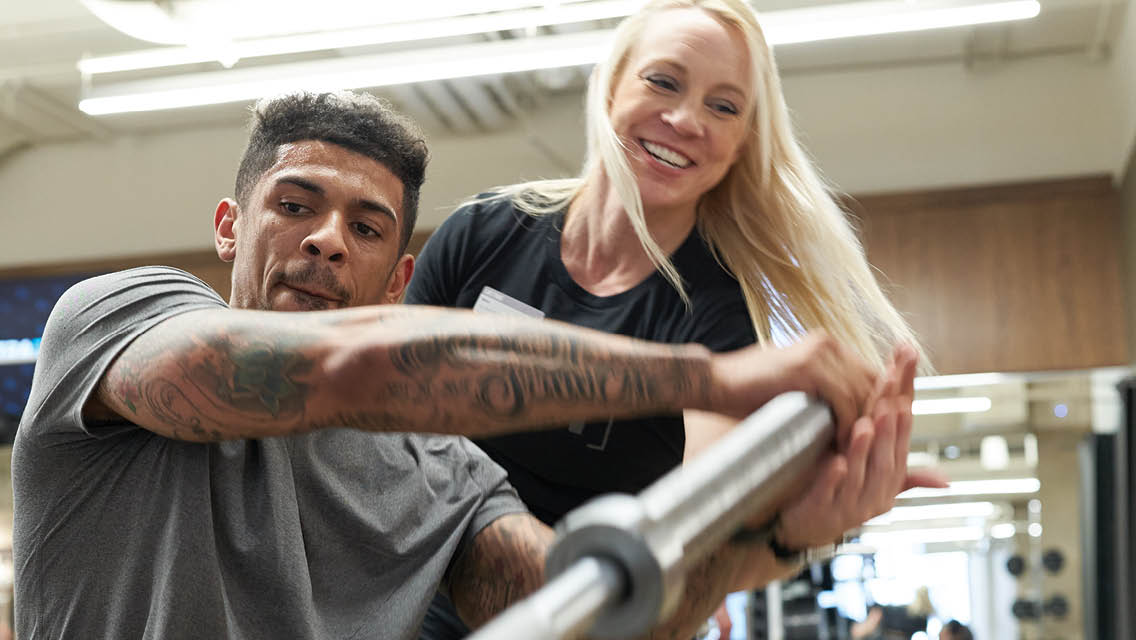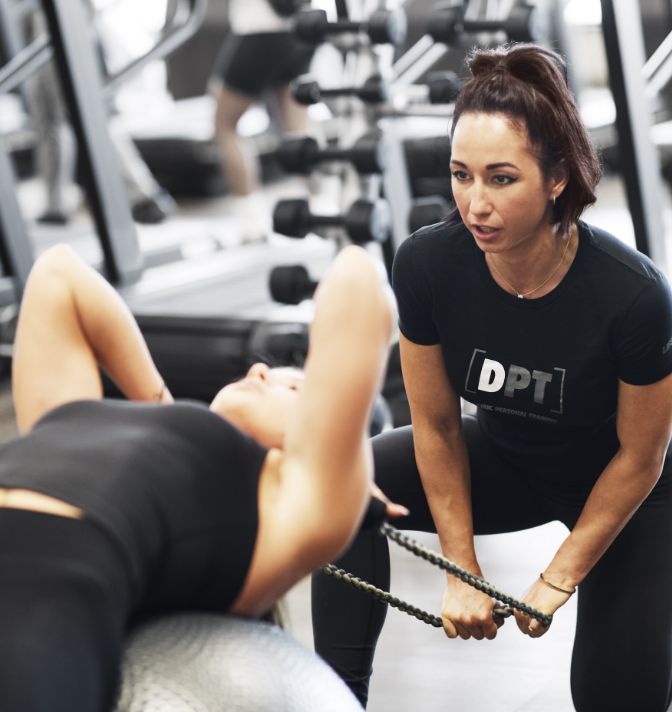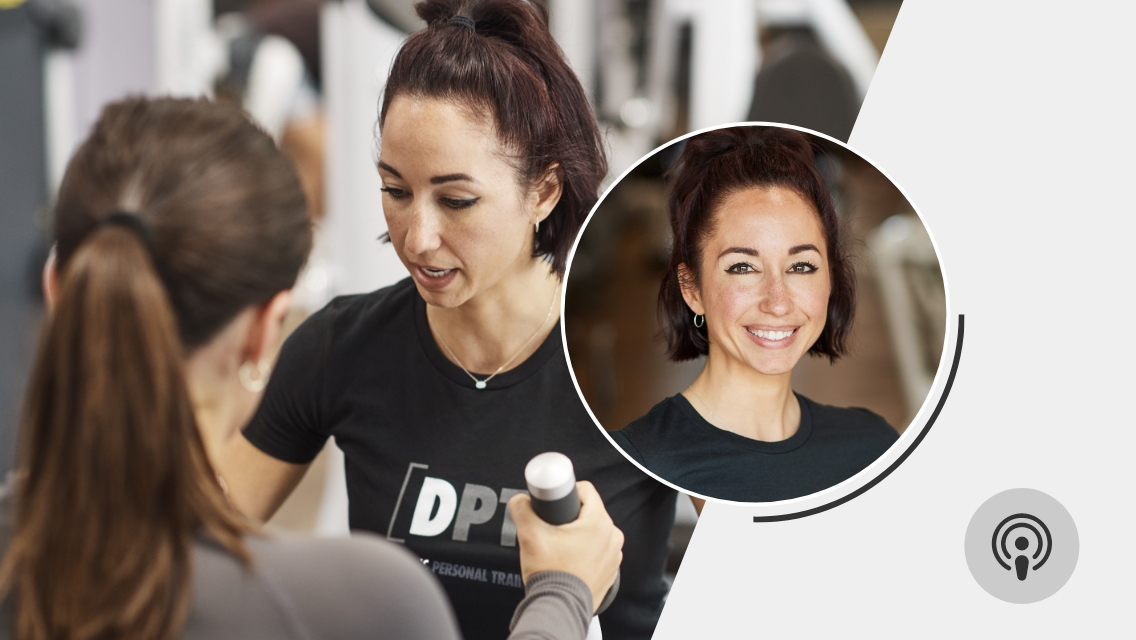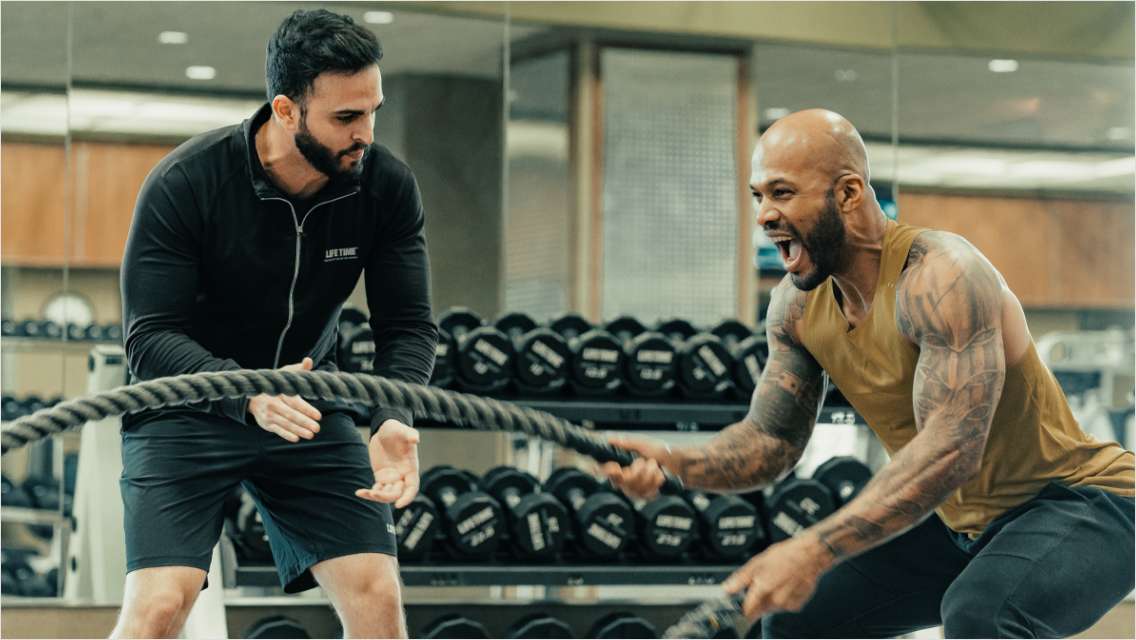Maybe you’ve seen it while working out at your health club: a personal trainer and client so connected and engaged you can’t help but watch from afar. Not only are they working together physically, but they also share a camaraderie, a clear sense of purpose, and a level of trust that seems to motivate the client to push a little harder or to try a move they might once have thought impossible.
This is Dynamic Personal Training.
Dynamic Personal Training is Life Time’s unique philosophy, which can be applied to any modality of training. “It’s a fully connected, fully engaged training experience that’s the result of two things coming together,” explains Amber McMillan, senior vice president of training and weight loss at Life Time. “It’s an elevated physical session and a deeper, more supportive trainer-client relationship.”
Often, the greatest obstacle to achieving our goals is not a physical limitation but rather the mental or emotional roadblocks that pop up along our healthy-living journeys. And that’s where Dynamic Personal Training shines.
“Sometimes it takes someone outside of us to help us see our full potential,” says McMillan. “Through positive coaching and habit reinforcement, Dynamic Personal Training helps individuals realize all they are capable of.”
The principles of Dynamic Personal Training can be layered onto any training session, from functional to athletic performance, regardless of an individual’s current health and fitness status, age, or goals. “Dynamic Personal Training takes the science of personal training and elevates it to an art form,” says Bahram Akradi, founder and CEO of Life Time. “It’s exchanging energy and information in a way that cannot be replicated on your own.”
Here, Danny King, a master trainer at Life Time, explains how Dynamic Personal Training, in practice, raises the bar on traditional personal training.
The Dynamic Warm-up
We all know how important a good warm-up is — and how easy it is to skip. Yet this portion of any workout offers essential information for your trainer: Did you just get up? Just come from the office? Where are you feeling aches and pains? Or stiffness and soreness from a previous workout?
This is an opportunity to wake up your body and get energized for the session ahead. “We could put some warm-up exercises on paper and have someone execute them on their own,” says King. “Or we can understand where they’re at and offer support and customization, such as putting a hand on their lower back to make sure they’re not compensating elsewhere, or giving an extra push to help them find mobility in their shoulder that they might not access on their own.”
Trainers might also use percussive devices to help loosen tight muscles before the real work of your session begins. “After a few minutes of this, I often find that people are standing a little taller, their posture is better, and they are prepared mentally and physically to do the work ahead,” King says.
The Workout
The actual work of a Dynamic Personal Training session includes progressive strength training, with functional movements (such as squats and pull-ups), followed by accessory strength exercises (think triceps extensions) that push you to muscle failure.
It typically concludes with conditioning to raise your heart rate: You might slam battle ropes, swing a kettlebell, or perform intervals on an airbike.
“The workout is a mix of hard work and some fun, which is kind of like the experience of riding a roller coaster — there are ups and downs,” explains King. “You might not love parts of it, but because it’s harder than you would push on your own, it’s what is needed to make the best progress.”
In each phase, you work with your trainer in a few key ways that differ from a typical training session.
Partner Movements
One of the key differentiators between Dynamic Personal Training and traditional personal training is partner movements. Your trainer will often be physically engaged with you — even, at times, working out alongside you.
Solo medicine-ball tosses, for instance, are great power moves in any training routine, but performing them with a partner offers a different level of activation. Your balance and coordination are tested; your resistance is challenged.
Partner exercises keep you — and your brain — fully engaged. They help you go a little further, because there’s someone in it with you and you push through it together.

Manual Resistance and Support
Using resistance bands, physical touch (for those who are comfortable with it and give permission), or other tools, a trainer tailors each exercise to your fitness or fatigue level in any given moment. They customize every movement to meet your ability, by either increasing or decreasing the challenge with pushing, pulling, and gentle resistance and support.
In a high plank, for instance, a trainer might use a resistance band to purposely pull you off balance; this activates a different set of core muscles — including the obliques — than a traditional plank or pushup would.
If the trainer notices you’re struggling, they can change the angle of the resistance band, which can provide enough support for you to finish the last few seconds. Eventually, as you build your strength and confidence, you won’t need that additional support.
Coaching and Cueing
Throughout your session, a trainer uses coaching and cueing to ensure you’re using proper form and activating the correct muscles. This might include verbal instruction and encouragement, touch, or all of the above.
Physical coaching and cueing help build the mind–muscle connection by gently creating awareness of the muscle group you’re working. When you perform a reverse fly using free weights, for example, your trainer may use their hand to draw your attention to your trapezius and rear deltoid muscles. Over time, increased proprioception will ensure that the right muscles fire together at the right time, ultimately producing better results.
A trainer may also use coaching and cueing to guide your breathing. When you’re squatting, for instance, they may remind you to inhale on the way down and exhale on the way up. They may also use cueing to correct your form, which can help prevent injury.
As fatigue sets in during the various strength-and-conditioning movements, your trainer is there to give you physical support and extra encouragement, inspiring you to lift a little heavier or push a little harder.
The Recovery
Once the workout is done, taking a few minutes for recovery provides the opportunity for your body and mind to absorb all you’ve accomplished. In addition to assisted stretching and percussive work, you and your trainer can discuss the workout and how to prepare for the next session. “It’s the cherry on top,” says King.
Dynamic Personal Training is differentiated from other types of training by the physical, mental, and emotional connection. “The experience of leaving a Dynamic Personal Training session is similar to that of walking away from a massage,” says Akradi. “There’s nothing quite like the sense of discovery and accomplishment it provides. It leaves you wanting more.”
And that can mean real progress toward your fitness goals.
This article originally appeared as “Dynamically Different” in the September 2022 issue of Experience Life.






This Post Has 0 Comments